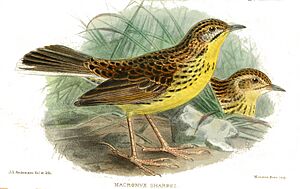Sharpe's longclaw facts for kids
Quick facts for kids Sharpe's longclaw |
|
|---|---|
 |
|
| Conservation status | |
| Scientific classification | |
| Genus: |
Macronyx
|
| Species: |
sharpei
|
The Sharpe's longclaw (Macronyx sharpei) is a special kind of bird that lives only in Kenya, Africa. It belongs to the longclaw family, which also includes birds called pipits and wagtails. These birds are known as passerines, meaning they are perching birds.
This bird is about 16 to 17 centimeters long. It has bright yellow feathers on its belly. Its back and wings are covered in brown and reddish streaks. When it flies, you can see white feathers on the outer parts of its tail.
Sadly, the Sharpe's longclaw is an endangered bird. This means there are not many of them left. Experts believe there are fewer than 20,000 of these birds. Their natural home, which is open grassland, is shrinking. People are using this land for farming or planting trees, which takes away the birds' habitat.
The bird's name, Sharpe's longclaw, honors a British zoologist named Richard Bowdler Sharpe.
Contents
About Sharpe's Longclaw
The Sharpe's longclaw was first described in 1904 by an English bird expert, Frederick John Jackson. He found these birds in the Mau Plateau area of Kenya. He gave it the scientific name Macronyx sharpei. Both the common name and the scientific name honor Richard Bowdler Sharpe, who was also an English bird expert and worked at a museum.
The Sharpe's longclaw is part of the Motacillidae family. This family includes other well-known birds like pipits and wagtails. Some scientists think this bird, along with the yellow-breasted pipit, should be in their own special group called Hemimacronyx. These two birds are very similar and are thought to be closely related.
Where Sharpe's Longclaw Lives
The Sharpe's longclaw lives in the high areas of western and central Kenya. It has a limited range, meaning it's found only in certain places. These places include the northern slopes of Mount Kenya and the southern slopes of the Aberdares. It also lives on the Gishu, Mau, and Kinangop Plateaus, which are around the Rift Valley. You might also find it on the Kenyan side of Mount Elgon.
This bird's favorite home is open grassland without trees. It likes areas with short, often clumpy grasses. It lives at altitudes between 1,850 and 3,400 meters (about 6,000 to 11,000 feet) above sea level. However, it is more commonly found below 2,800 meters (about 9,000 feet). It usually lives higher up than another bird called the yellow-throated longclaw. The Sharpe's longclaw generally does not migrate long distances. But it might move short distances if its home becomes too dry.
How Sharpe's Longclaw Behaves
What Sharpe's Longclaw Eats
The Sharpe's longclaw mainly eats insects. It especially likes grasshoppers and beetles. It also eats other small creatures without backbones. In areas where there are clumps of grass, the bird tends to find more food. It usually looks for food alone or in pairs. Sometimes, you might see small family groups feeding together.
How Sharpe's Longclaw Reproduces
The Sharpe's longclaw is a monogamous bird, meaning a male and female stay together to raise their young. They are also solitary breeders, which means they defend their own space for nesting. The breeding season usually happens during or after the rainy periods. This can be from March to June, September to October, and in December.
During breeding season, the male bird performs a short aerial display. It flies up into the air and then drops down, singing very quickly as it falls. The nest is carefully built like a cup using dried grass. It is lined with roots and placed close to the ground. You can often find it at the bottom of a clump of grass or under a small bush or plant. The female usually lays two or three eggs.




